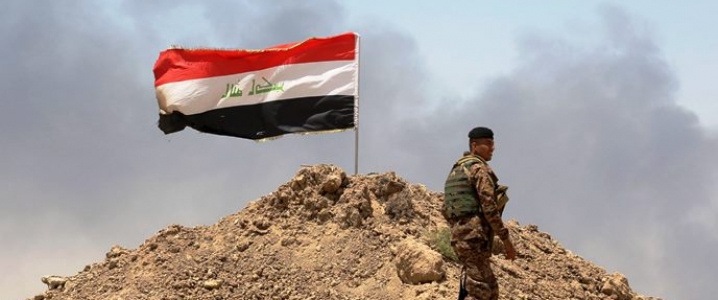Iraq’s future is again tottering with protests erupting of the country. Baghdad is being confronted by internal unrest, as economic and social problems have spilled over into the political arena.
Protests and strikes have been reported in the major oil port of Basra, while reports are also mentioning protests in the provinces Dhi Qar, Wasit, Maysan and Babil. Peaceful protests seem now to have crossed a red line, as protesters and security forces have clashed near the Iranian border at Amara, with several injured and 2 killed as reported by NBC News. Violence also has erupted in the holy city of Najaf, where protesters stormed buildings and the airport.
A majority of the protests at present are focusing on the growing influence of Iran. Direct attacks have been reported on offices of the Kata’ib Hezbollah in Najaf, Dawa, Badr and other places. Kata’ib Hezbollah is directly linked to Iran and its Iranian Revolutionary Guard Corps (IRGC).
The protests erupted following the elections in May, in which to the surprise of many, Shi’a leader Muqtada Al Sadr came out victorious. Former pro-Iranian militia groups were voted in as second force, while Iraq’s PM block came in third.
Until now, no new government has been formed and the election results are even being questioned, as many fear that widespread election fraud occurred throughout the country. The formation of a Shi’a led pro-Iranian government seems the most feasible at present.
At the same time, Iraq’s economy is being hit by a crisis in which corruption and a total failure of investment strategies has caused the population to turn against Iraqi Prime Minister Haidar al-Abadi. The current stagnating economy and the lack of transparency is being blamed on the pro-Iranian parties, or even the total Iranian power in the country. Related: Record Oil Production Doesn’t Free U.S. From Global Market
It seems that the ongoing widespread protests in Iran, which have still been underreported in mainstream media, are supporting the current protests in Iraq too. People throughout the whole region are fed-up with the increased cooperation between Baghdad and Tehran.
The anti-Iran and Baghdad protests come at a very bad moment. After the removal of ISIS in almost all of Iraq, the current power struggle and economic crisis have again given room to a re-emergence of the terrorist group. Since the elections in May, ISIS has stepped up its attacks throughout the whole country. Iraqi special forces are currently battling with ISIS groups in the Salahuddin, Diyala, Kirkuk and Nineveh provinces. These operations are partly successful, but no end to the violence is in sight.
Even though no real damage has been reported in Iraq’s southern oil and gas fields or energy infrastructure, parties are aware of the fact that more violence could easily spread to southern Iraqi ports or directly to up- and downstream projects in the region. Protests have been confirmed around Basrah’s oil and gas plants and infrastructure, but until now, crude exports remain unaffected. Sources have indicated that some production in the Majnoon field has been suspended, but figures have not been given.
The ongoing protests in the Basrah area, however, could have a detrimental impact on Iraq’s export capabilities. The clashes and severe actions taken by security forces against protestors could spill over to the energy infrastructure of the region soon. Until now the protests have been effectively suppressed, but new clashes with Iraqi army and security troops are to be expected. Al-Abadi has ordered new reinforcements to go to Basrah and other southern cities to quell the unrest.
A threatening sign of things to come is the fact that the already fledgling internet in Iraq has been shut down in the protest areas. The severity of the overall situation has become clear after that Abadi, who attended the NATO Summit in Brussels, where also U.S. president Trump and several Arab leaders also met, left the meeting to lead the actions against the protests.
How far the Abadi-government will be able to quell the current unrest is unclear. For most protesters, the fact that the Basrah region is the main provider of oil and gas revenues but no real changes are seen on the street is the main point of conflict. Al Abadi also needs to counter a potentially larger opposition force; Grand Ayatollah Ali Al Sistani.
Al Aistani has put his own position behind the protests. If Al Sistani and Al Sadr would join forces and openly support the protests, the days of Al Abadi could be numbered. A power struggle could emerge on the streets of Basrah, Karbala and other places, leaving Iraq in shambles.
Related: Oil Retraces On Libyan Production Surge
The latest reports indicate that protestors already have the oil and gas fields in the south in their sight. Protestors are currently surrounding the Siba natural gas field, which is run by Kuwait Energy.
At the same time, news is emerging that protestors are at the gates of Iraq’s main oil fields, West Qurna 1, West Qurna 2 and Rumaila. An eruption of violence in this region could potentially decimate the export volumes of the country. At present, Iraq is the second-largest producer in the Organization of Petroleum Exporting Countries, with a production of around 4.5 million bpd.
Baghdad’s overall production is reported to have surged last month by 122,000 bpd and around 1/3 of total production is located in the Basrah province. Oil prices would spike if Iraq were to see major outages and OPEC won’t be able to compensate for it.
By Cyril Widdershoven for Oilprice.com
More Top Reads From Oilprice.com:
- Are Bionic Cells The Future Of Solar?
- U.S. Poised To Ease Biofuel Quotas
- Gazprom’s Next Giant Gas Field


















